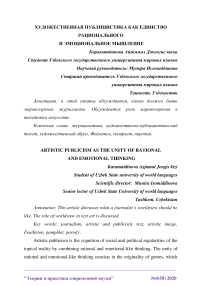Artistic publicism as the unity of rational and emotional thinking
Автор: Karamatdinova A.Je., Isomiddinova M.
Журнал: Теория и практика современной науки @modern-j
Рубрика: Основной раздел
Статья в выпуске: 4 (58), 2020 года.
Бесплатный доступ
This article discusses what a journalist’s worldview should be like. The role of worldview in text art is discussed.
Journalism, artistic and publicistic text, artistic image, feuilleton, pamphlet, parody
Короткий адрес: https://sciup.org/140275390
IDR: 140275390 | УДК: 629.4
Текст научной статьи Artistic publicism as the unity of rational and emotional thinking
Artistic publicism is the cognition of social and political regularities of the topical reality by combining rational and emotional-like thinking. The unity of rational and emotional-like thinking consists in the originality of genres, which offer interpretive information based on artistic analysis of phenomena and characters. It is an image of life, not a reasoning about it. There is always a person in or behind the scenes. From journalism these genres have taken political focus, sharpness, relevance, logical and rational system of research, and from fiction - the image system and style. Artistic and journalistic text - a single whole, in which the journalistic and figurative components complement each other. [1]
Specificity of the publicist image. The specificity of the image of reality in art publicism is connected with figurative understanding of facts. In this case it is necessary to distinguish the mental image from the image as an aesthetic category, and artistic image from the image of the publicist. To mental images are feelings, ideas, memories, fantasies, dreams. Mental image is a sensually perceived individual representative of individual objects and phenomena.
Reflecting on the combination of rational and figurative in the space of the publicist text, we must remember that it is not only about the special expressiveness of the speech system. The abundance of metaphors or other trails of speech will not turn an article into an essay. It is necessary to distinguish emotionality from figurativeness. It is important to realize that artisticity in an essay or a feuilleton is not only and not so much a literary commentary on the topic, but an inner necessity, the spring of the text.
Details in an artistic and publicistic text. Taking into account the limited volume of an art-publicistic text, the detail is the most technologically advanced method of creating a publicistic image. It is the main means of artistic typification. Precise and vivid detail allows a few strokes to convey the characteristic features of human appearance, speech, manners, convex and visually describe the situation, place of action, object, or even the whole phenomenon. For this, the detail must be specific and capacious. The first one is to isolate the supporting detail from the abundance of impressions. For this purpose, it is necessary to imagine the idea of the work, which will allow paying attention to some specific features of the information object. Further, it is necessary to make this supporting detail the center not only of the logical but also of the artistic concept of the work. Depending on this, it is necessary to think about the deployment of figurative text construction and microdetailing.
Among the supporting details distinguish details-images and details-symbols. Detail-image captures the most essential characteristics of a character or phenomenon, about which the author writes (some object). Unlike the figurative detail, the symbolic detail contains some symbolic generalization that accompanies this detail from the cultural history.
The second method of detailing is the use of micro-details, which play an auxiliary role in the text. General characteristics of art and publicist genres: 1) Reflect the entire spectrum of social relations. 2) Synthesize the emotional and rational and cognitive reflection of reality, i.e. science and art, literature and sociology. 3) Have their own style features, which are due to: - extra-linguistic factors (relevance, efficiency, periodicity, the author's pronounced attitude to the content of the statement), - functions of publicism (unity of information and influencing functions) - documentality and object.
Art and publicist genres are the most complex, here, along with the content, a special aesthetic role plays form. This presupposes increased demand for language, artistic imagery and emotional saturation.
The central place among these genres is occupied by the essay. The essay combines reportage, research and writing. It does not just communicate facts and conclusions, but also artistic generalization and comprehension of reality. Unlike analytical articles, the essays are quite appropriate metaphors and other artistic techniques. Such kinds of essays as a portrait essay and a problematic essay are distinguished.
Feuilleton is a satirical genre. Its aim is to ridicule all sorts of vices. The success of a feuilleton depends on the clarity of the facts and linguistic taste of the feuilletonist. About the origin of the feuilleton preserved legend: in 1800 in the "Magazine de Deba" editor has invested in another issue of the newspaper an additional sheet. The first feuilleton "Journal de Deba" contained a repertoire of theaters, poetic riddles, charades, puzzles, poems and ads sent subscribers. [2]
The pamphlet is close to the feuilleton. If a feuilleton ridicules a negative phenomenon, the pamphlet - the hero, which is presented to the author a carrier of dangerous social evil.
The parody is a satirical image of someone else's speech: a literary work, political performance, scientific or philosophical work.
A small genre is a satirical commentary, which differs from the analytical approach to the use of artistic means (irony, hyperbole). An essay is a genre that has close proximity to scientific, journalistic and fiction literature, but does not belong to any of them entirely.
Список литературы Artistic publicism as the unity of rational and emotional thinking
- Light, Larry, "How Brand Journalism Is Impacting Brand Management", Adage.com, 21.07.2014 http://adage.com/article/guest-columnists/brand-journalism-a-modern-marketing-imperative/294206
- Oftelie, Erin, "What Is Brand Journalism?", Community.Copypress.com, 01.04.2014, http://community.copypress.com/what-is-brand-journalism


